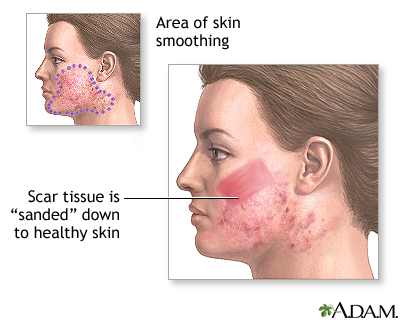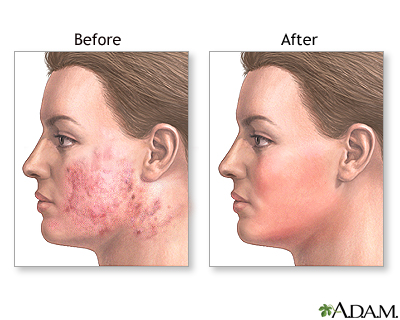Health Library
Skin smoothing surgery - series

Indication
Dermabrasion may be offered to patients with:
- Facial scars from acne, accidents, and previous surgery
- Fine facial wrinkles, such as around the mouth
- Precancerous growths (keratoses)

Procedure
Dermabrasion is usually done while you are awake. You will receive local anesthesia. This means the doctor will numb the area to be worked on.
A surgical instrument is used to gently and carefully "sand" the scar tissue off down to normal, healthy skin. The healing tissue is treated with ointments (such as petroleum jelly or antibiotic ointments) to reduce scab formation (crusting) and therefore reduce scar formation.

Aftercare
The skin may be treated with ointment and a wet or waxy dressing. After surgery, your skin will be quite red and swollen. Eating and talking may be difficult. You may have some aching, tingling, or burning for a while after surgery. Your doctor can prescribe medicine to help control any pain.
Swelling usually goes away within 2 to 3 weeks. New skin starts to itch as is grows. If you had freckles, they may temporarily disappear.
If the treated skin remains red and swollen after healing has started, this may be a sign that abnormal scars are beginning to form. Talk to your doctor. Treatment may be available.
The new layer of skin will be a little swollen, sensitive, and bright pink for several weeks. Most patients can go back to normal activities in about 2 weeks. You should avoid any activity that could cause injury to the treated area. Avoid sports that involve balls, such as baseball, for 4 to 6 weeks.
Protect the skin from the sun for 6 to 12 months until your skin coloring has returned to normal.
Related Information
DermabrasionBACK TO TOP
Review Date: 11/30/2022
Reviewed By: Ramin Fathi, MD, FAAD, Director, Phoenix Surgical Dermatology Group, Phoenix, AZ. Also reviewed by David C. Dugdale, MD, Medical Director, Brenda Conaway, Editorial Director, and the A.D.A.M. Editorial team.
 | A.D.A.M., Inc. is accredited by URAC, for Health Content Provider (www.urac.org). URAC's accreditation program is an independent audit to verify that A.D.A.M. follows rigorous standards of quality and accountability. A.D.A.M. is among the first to achieve this important distinction for online health information and services. Learn more about A.D.A.M.'s editorial policy, editorial process and privacy policy. A.D.A.M. is also a founding member of Hi-Ethics. This site complies with the HONcode standard for trustworthy health information: verify here. |
The information provided herein should not be used during any medical emergency or for the diagnosis or treatment of any medical condition. A licensed medical professional should be consulted for diagnosis and treatment of any and all medical conditions. Links to other sites are provided for information only -- they do not constitute endorsements of those other sites. No warranty of any kind, either expressed or implied, is made as to the accuracy, reliability, timeliness, or correctness of any translations made by a third-party service of the information provided herein into any other language. © 1997- 2025 A.D.A.M., a business unit of Ebix, Inc. Any duplication or distribution of the information contained herein is strictly prohibited.
